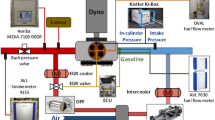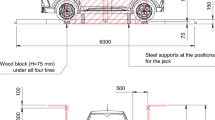Abstract
Alcohol fuels have been considered for use as automotive fuel since two energy crises in the 1970's, but they have a defect of high latent heat of vaporization. Therefore, in order to improve vaporization of methanol, the authors have made the fuel vaporizing device with which to heat the mixture and eliminate the fuel film flow. This paper is a study on the characteristics of vaporization and engine performance acoording to the change of heating water temperature by means of the fuel vaporizing device. The study shows that as the vaporization of mixture improves, the mixture of methanol becomes homogenized and the fuel film flow decreases, which results in the increase of vaporization rate. And the increase of the vaporization rate improves the engine performance of the alcohol-fueled spark ignition engine.
Similar content being viewed by others
Abbreviations
- A a :
-
Area per unit length
- A m :
-
Area per unit length mesh
- C p :
-
Specific heat at constant pressure
- D :
-
Diameter of inlet pipe
- d :
-
Diameter of a mesh inlet pipe
- G f :
-
Mixture flow of vapor
- G s :
-
Mixture flow of droplet
- G w :
-
Mixture flow of liquid
- h :
-
Heat transfer coefficient
- K :
-
Thermal conductivity
- L a :
-
Length of the FVD
- M :
-
Mass
- N :
-
Engine speed
- Pr :
-
Prandtl number
- Q :
-
Heat transfer rate
- Q h :
-
Heat quantity of mixture
- R af :
-
Air fuel ratio
- R e :
-
Reynolds number
- T :
-
Temperature
- T b :
-
Bulk temperature
- T w :
-
Wall temperature
- V d :
-
Displacement volume
- V :
-
Velocity
- X e :
-
Vaporization rate
- γ:
-
Specific weight
- δ:
-
Interval of a mesh
- η υ :
-
Volumetric efficiency
- θ:
-
Crank angle
- ρ a :
-
Density of air
- ϕ:
-
Equivalence ratio
- ρ:
-
Density
- a :
-
Air
- f :
-
Fuel
- i :
-
i'th component
References
Baines, T. M., Smith, L. R. and Urban, C. M., 1982, “Regulated Exhaust Emission from Methanol-Fueled Cars,” SAE Paper No. 820967, pp. 3171–3180.
Bechtold, R. and Pullman, J. B., 1980, “Driving Cycle Economy, Emissions and Photochemical Reactivity Using Alcohol Fuels and Gasoline,” SAE Paper 800260.
Hagen, D. L., 1977, “Methanol as a Fuel: Review with Bibliography,” SAE Paper 770792, pp. 2764–2796.
Han, S. B., Mun, S. S., Lee, N. H., Lee, J. T. and Lee, S. Y., 1993, “Characteristics of the Engine Performance of the Methanol Fueled Spark Ignition Engine by the Fuel Vaporizing Device,” Tenth International Symposium on Alcohol Fuels.
Harrington, J. A., Shishu, R. C. and Asik, J. R., 1974, “A Study of Ignition System Effects on Power, Emission, Lean Misfire Limit and EGR Tolerance of Single-Cylinder Engine-Multiple Spark Versus Conventional Single Cylinder Spark Ignition,” SAE Paper 740188, pp. 837–845.
Katoh, K., Imamura, Y. and Innnoue, T., 1986, “Development of Methanol Lean Burn System,” SAE Paper No. 860247, pp. 236–244.
Mun, S. S., Han, S. B. and Lee, S. Y. 1986. “A Study on the Characteristics of Vaporization Using Fuel Vaporizing Device in a Methanol Fueled Spark Ignition Engine.” In Proceedings of the KSME Spring Annual Meeting, pp. 394–397 in Korea.
Samaga, B. S. and Kumar, Y. S., 1986, “Performance St Studies on a Methanol-Fueled Stratified Charge Combustion Engine,” In Proceedings of the VII International Symposium on Alcohol Fuels, pp. 142–147.
Schweikert, J. F., 1976, ”Emission Control with Lean Mixture,” SAE Paper 760226, pp. 1041–1055.
Author information
Authors and Affiliations
Rights and permissions
About this article
Cite this article
Han, S.B., Mun, S.S. & Lee, S. Vaporization characteristics of the alcohol-fueled spark ignition engine. KSME Journal 8, 241–247 (1994). https://doi.org/10.1007/BF02953352
Received:
Issue Date:
DOI: https://doi.org/10.1007/BF02953352




